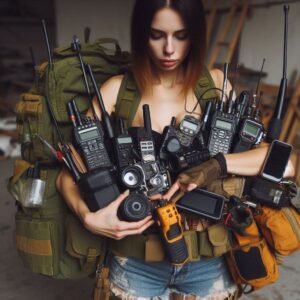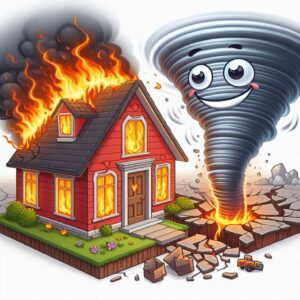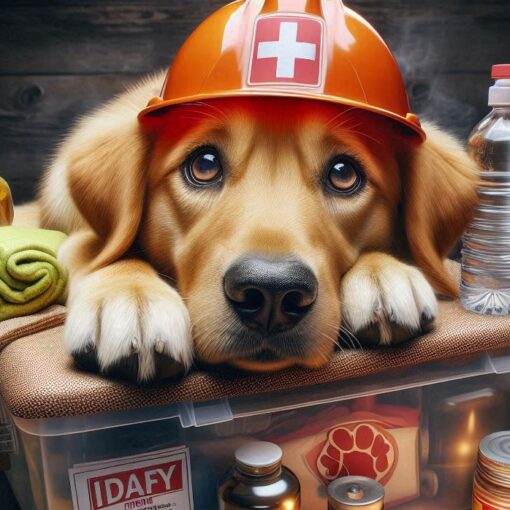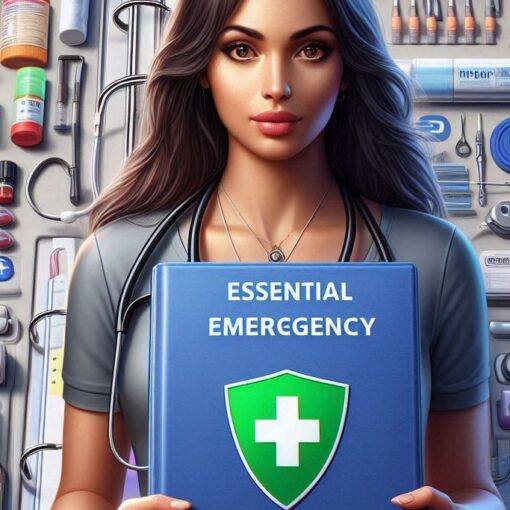 Preparing for unexpected emergencies is a good call. I mean, it’s like wearing a raincoat in the middle of summer—you might look a bit silly at first, but when the skies open up and everyone else is soaked to the bone, you’ll be strutting around like a fashion-forward duck.
Preparing for unexpected emergencies is a good call. I mean, it’s like wearing a raincoat in the middle of summer—you might look a bit silly at first, but when the skies open up and everyone else is soaked to the bone, you’ll be strutting around like a fashion-forward duck.
The world is full of surprises—like discovering that your favorite shirt now comes in a size called “invisible,” or that adulting actually requires being responsible. Who knew? It’s enough to make you wonder if we all accidentally signed up for some cosmic joke.
But don’t worry! Preparing for emergencies isn’t as intimidating as it sounds. You won’t need to channel your inner Rambo or start building an underground bunker stocked with enough canned beans to last through three apocalypses.
Unless that’s your thing, of course—if so, go nuts! Just remember: there’s a fine line between preparedness and paranoia, and we’re aiming for the former here.
So let’s chat about how to prep for any type of emergency—from natural disasters that could make even Mother Nature rethink her life choices, to that heart-stopping moment when you glance at your phone and see it hovering at 2% battery life while you realize you’ve forgotten your charger. Talk about existential dread!
It’s like finding out you’ve been invited to a potluck without knowing what dish you’re supposed to bring—panic mode engaged!
First things first: let’s break down what “emergency” really means. It can range from something serious like an earthquake (which feels like the ground is auditioning for a role in a horror movie) to more everyday catastrophes like losing Wi-Fi during binge-watching sessions—gasp!
 In both cases, having a plan is crucial. Think of it this way: would you jump into a swimming pool without checking if there was water in it first? Probably not unless you’re trying out for an extreme sport called “making bad decisions.”
In both cases, having a plan is crucial. Think of it this way: would you jump into a swimming pool without checking if there was water in it first? Probably not unless you’re trying out for an extreme sport called “making bad decisions.”
Now, where do we start? A good emergency kit is like having insurance—it’s one of those things you hope never comes in handy but are incredibly grateful for when it does. Imagine walking into someone’s house and seeing them proudly display their meticulously organized emergency supplies—it’s kind of like showing off your stamp collection but with less judgment and more flashlights.
You’ll want basic stuff: water (enough to hydrate yourself through a marathon Netflix session), non-perishable food (because nobody wants tuna fish after it’s been sitting on the shelf since 2010), first-aid supplies (for those moments when DIY projects go horribly wrong), and maybe even some batteries—for all those devices that seem determined to die right when you need them most.
And hey, don’t forget about communication plans! In our digital age where we expect instant replies faster than our morning coffee kicks in, having backup methods can save us from turning into anxious squirrels searching for acorns—or worse yet, yelling “Can anyone hear me?” into the void while hoping our loved ones are just as frantic.
So grab your notepad—or better yet, open up that notes app before realizing you’ve run out of battery—and let’s dive deeper into how to prepare effectively without losing our minds or dignity along the way. After all, nobody wants to be caught unprepared while simultaneously trying to figure out if they should panic or laugh maniacally at their own misfortune. Ready? Let’s roll!
Step 1: The Mental Prep
Before you start buying out the camping aisle at Walmart like it’s Black Friday and you’re hunting for the last TV, let’s get one thing straight: mindset is everything. Seriously, if your brain is a chaotic mess of panic and confusion, you might as well be trying to assemble IKEA furniture without the instructions—good luck with that! You need to be calm, collected, and just a smidge paranoid—but the good kind.
You know, like when you double-check to make sure you locked the door before leaving home. Not the kind that makes you think your toaster has been plotting against you since 2007.
Accepting that emergencies can happen is crucial. It’s like acknowledging that your favorite snack will eventually run out—no matter how much denial you throw at it. And let’s face it: none of us are invincible.
Spoiler alert: Life isn’t a Marvel movie where everyone walks away from explosions looking fabulous while sipping lattes. Sorry to break it to you, but you’re not Tony Stark (unless you’ve got a secret suit hidden in your closet).
 So what does this mindset look like? Imagine preparing for an unexpected storm while keeping your cool as if you’re waiting for your coffee order—annoyed but still hopeful. You need to accept that sometimes life throws curveballs that can knock even the best of us off our feet.
So what does this mindset look like? Imagine preparing for an unexpected storm while keeping your cool as if you’re waiting for your coffee order—annoyed but still hopeful. You need to accept that sometimes life throws curveballs that can knock even the best of us off our feet.
But here’s the kicker: having a plan doesn’t mean living in fear; it means being ready for whatever wacky twist life decides to throw at you next.
Think about it this way: would you head out on a road trip without checking your gas tank first? Of course not! That would be madness akin to running into a buffet with no idea what food allergies you have—it could end badly! Instead, approach emergencies with a sense of readiness mixed with just enough humor to keep things light.
After all, if we can laugh at ourselves when we misplace our keys for the umpteenth time or accidentally text our boss instead of our buddy about last night’s escapades, we can definitely chuckle about being prepared for life’s little surprises.
So take a deep breath and embrace this slightly paranoid yet empowered mindset. It’s all about striking that balance between “I’ve got this” and “What was I thinking?” Because when push comes to shove—and trust me, it will—you’ll want to be ready without feeling like you’ve turned into some survivalist hermit living off granola bars and conspiracy theories about kitchen appliances.
Now grab yourself a pen and paper; it’s time to jot down some practical steps so we don’t end up crying over spilled milk—or worse—spilled emergency supplies!
Step 2: The Basic Survival Kit
 Now, every emergency prepper guide will tell you to have a survival kit. And they’re right, but they’re also wrong because they make it sound like you need to pack for the zombie apocalypse. So, let’s simplify:
Now, every emergency prepper guide will tell you to have a survival kit. And they’re right, but they’re also wrong because they make it sound like you need to pack for the zombie apocalypse. So, let’s simplify:
Water: The rule of thumb is one gallon per person per day. Multiply that by how many days you think you might be stranded in your living room binge-watching Netflix while the power’s out.
Food: Non-perishables are key. Think canned goods, dried fruits, nuts, and maybe a little chocolate because, let’s be honest, you’ll need something to lift your spirits when the Wi-Fi’s down.
First Aid Kit: Band-aids, antiseptic, pain relievers, and whatever else you need to survive a minor injury. No, a paper cut does not count as an emergency, but you’ll be glad you have the band-aid when it happens.
Flashlight: And extra batteries. Or a crank-powered one if you want to get some exercise in while you’re at it.
Blankets and Warm Clothing: Because shivering like you’re auditioning for “Frozen 3” isn’t as fun as it sounds.
Multi-tool: Swiss Army knife, Leatherman, or whatever you prefer. It’s like the Swiss Army knife of, well, Swiss Army knives.
Step 3: Know Your Evacuation Plan
I know, “evacuation plan” sounds like something straight out of a disaster movie—complete with dramatic music and people running in slow motion.
Trust me, when the fire alarm goes off at 3 AM and you’re standing there in your underwear, squinting at the ceiling like it’s going to provide some answers, you’ll wish you’d planned ahead. Seriously, nothing says “I’ve got my life together” quite like knowing exactly where your exits are when chaos strikes.
First things first: know your exits. This isn’t just about figuring out how to escape; it’s like playing an intense game of human chess where every second counts. You need to have a mental map that would make even Google Maps jealous.
And while you’re at it, remember where your car keys are! Because let’s be honest: if you can’t find those little metal devils during an emergency, you’re basically stuck playing hide-and-seek with yourself while everyone else is making their grand exit.
 And let’s not forget about our furry friends—because they don’t care about your evacuation plan unless it involves treats or belly rubs. Have a plan for them too! Preferably one that doesn’t involve strapping a GoPro to your cat and hoping for the best.
And let’s not forget about our furry friends—because they don’t care about your evacuation plan unless it involves treats or belly rubs. Have a plan for them too! Preferably one that doesn’t involve strapping a GoPro to your cat and hoping for the best.
Trust me, Fluffy won’t appreciate being part of a reality show when she could be hiding under the couch judging your panic from afar.
So here’s the deal: take ten minutes today to figure out what you’d do if disaster struck. Create an evacuation route that even a toddler could follow (bonus points if they can draw it).
Put together an emergency kit that includes essentials—like water, snacks, and maybe even some chocolate because let’s face it: stress-eating is real. And if you’re feeling particularly adventurous, toss in a few board games for good measure; nothing breaks tension like Monopoly…or starts family feuds!
In short, planning ahead might feel as exciting as watching paint dry on a rainy day—but I promise you’ll thank yourself later when you’re not standing there wondering if it’s too late to call for help or if you should just try to slide down the stairs on a mattress. Spoiler alert: don’t do that.
Step 4: The Important Documents
 Nobody likes paperwork. It’s right up there with root canals and stepping on Lego bricks—universally dreaded yet somehow unavoidable.
Nobody likes paperwork. It’s right up there with root canals and stepping on Lego bricks—universally dreaded yet somehow unavoidable.
But let me tell you, when an emergency hits, having your important documents handy is as essential as knowing where the nearest bathroom is during a road trip.
I’m talking about IDs, insurance papers, medical records, and yes, that love letter you wrote in high school but never had the guts to send because you thought “Dear Sarah” sounded way too formal.
So here’s the game plan: gather all those precious papers and stash them in a waterproof, fireproof bag. Think of it as your personal superhero cape for document protection.
Sure, it might feel like you’re preparing for a dramatic reveal on “Unsolved Mysteries,” complete with ominous music and that weird host who always looks like he just emerged from a time machine—but trust me, it’s worth it.
Imagine this: you’re standing in front of a raging storm or some other disaster movie scene unfolding outside your window. You’ve got your trusty bag by your side filled with everything you need to prove your identity and claim that sweet insurance money for whatever calamity just struck.
Meanwhile, everyone else is frantically searching through drawers like they’re auditioning for a reality show called “Who Can Find Their Birth Certificate First?” Spoiler alert: it’s not going to be them.
And let’s be honest—if something catastrophic happens and you’re scrambling around trying to remember where you put that random paper trail from 2015 about your car insurance policy while simultaneously wondering if Fluffy will survive without her favorite toy… well, that’s just stress waiting to happen!
So take five minutes today (yes, I know that feels like asking for an eternity) and organize those documents into one convenient spot. Label the bag clearly so even your sleep-deprived self can find it later without resorting to interpretive dance moves in front of confused family members.
It may seem tedious now, but think of it as life’s little insurance policy against chaos—a tiny investment in peace of mind that pays off big when things go sideways.
In short, don’t underestimate the power of being prepared. After all, nobody ever said planning ahead was glamorous—but at least you’ll have all the paperwork ready when life decides to throw its next curveball!
Step 5: Communication
In the age of smartphones, not being able to contact someone feels like stepping back into the Stone Age. Seriously, it’s horrifying! Imagine standing there, staring at your phone, and all it can do is play “Snake” while you’re left wondering if your loved ones are okay or if they’ve turned into zombies.
 Spoiler alert: when cell towers go down, that sleek little device in your pocket suddenly becomes as useful as a chocolate teapot.
Spoiler alert: when cell towers go down, that sleek little device in your pocket suddenly becomes as useful as a chocolate teapot.
So what’s the solution? Walkie-talkies. Yep, those little boxes of nostalgia that make you feel like a secret agent on a mission—or maybe just kids playing spy games in the backyard.
They’re basically texting without the emojis—no more “LOL” when you could just say “help!” And let’s be real; who doesn’t want to feel like they’re part of an action movie while trying to communicate with their family during an emergency?
But here’s another pro tip: have a list of emergency contacts written down. Yes, I said written down—on actual paper! I know this sounds archaic, but hear me out.
In an emergency situation where technology decides to take a vacation (because why would it work when you need it most?), that crumpled piece of paper won’t require charging or Wi-Fi access. It’ll be sitting there patiently waiting for you like a loyal dog that hasn’t been fed in days.
Think about it: how many times have you tried to remember Aunt Mildred’s phone number only to realize it’s buried deep within your phone’s address book under “Contacts I Never Call”? Now imagine you’re frantically searching for her number while dodging flying debris from whatever disaster is happening outside. Not fun!
So grab some old-fashioned pen and paper and jot down important numbers—family members, friends, even that neighbor who always borrows your lawnmower but never returns it. Keep this list somewhere easy to find because during chaos, finding anything can feel like searching for a needle in a haystack… blindfolded… on roller skates.
In summary, when technology fails us—and trust me, it will—you’ll be glad you took these simple steps. So embrace your inner Boy Scout (or Girl Scout) and get prepared! After all, it’s better to be ready than stuck yelling “Can you hear me now?” into the void while Fluffy looks on with judgmental eyes.
Step 6: Practice Makes Prepared
Ever tried to assemble IKEA furniture without cracking open the instructions? It’s like attempting to solve a Rubik’s Cube while blindfolded and standing on one leg. You might end up with something that resembles a chair, but it could also be an abstract art installation that defies all logic.
The same principle applies to emergency preparedness—if you don’t know what you’re doing ahead of time, you might as well be trying to build a rocket ship out of popsicle sticks.
So let’s talk practice. You wouldn’t jump into a marathon without training (unless your idea of fun is regretting every life choice for the next week), so why would you skip practicing your emergency plan?
 Picture this: fire drill time! You’ve got your little pep talk ready, and then—bam! The alarm goes off. Do you freeze like a deer in headlights or spring into action like a contestant on “Survivor”?
Picture this: fire drill time! You’ve got your little pep talk ready, and then—bam! The alarm goes off. Do you freeze like a deer in headlights or spring into action like a contestant on “Survivor”?
And then there’s the tornado scenario. If you have a basement, congratulations! You’ve won half the battle. Now just make sure it doesn’t look like a scene from “Hoarders.” If not, prepare to dive under something sturdy and hope that whatever’s lurking in the corners—yes, I’m talking about that giant spider—isn’t planning its own escape route at the same time.
Now let’s not forget earthquakes. When those start shaking things up, your best move is to duck, cover, and hold on tight like you’re riding the world’s worst rollercoaster—the kind where the operator forgot to check if all the safety harnesses were working properly.
Seriously, it’s all about protecting yourself from flying debris while praying that your collection of decorative plates doesn’t decide this is their moment for dramatic exit.
In short, practicing different scenarios isn’t just smart; it’s essential. Think of it as rehearsing for life’s unexpected plot twists. Because when chaos strikes—and trust me, it will—you want to be less “What do I do?” and more “I’ve got this!”
So grab some friends or family members and turn these drills into family bonding moments instead of awkward silence-filled exercises in panic management. After all, nothing says togetherness quite like preparing for natural disasters… right?
Step 7: Keep Your Cool
When the proverbial crap hits the fan—and let’s face it, we all know that moment is just around the corner—keeping your cool is crucial. I mean, seriously, panic is like adding hot sauce to a recipe that already has too much spice; it just makes everything worse.
Ever seen someone freak out and decide to climb a tree during a thunderstorm? Yeah, good luck with that. You might as well be trying to win a game of dodgeball against lightning.
 And let’s talk about bears for a second. If you ever find yourself in a situation where you think you can outrun one, let me save you some time:
And let’s talk about bears for a second. If you ever find yourself in a situation where you think you can outrun one, let me save you some time:
Spoiler alert—you can’t outrun a bear! Not unless you’re secretly training for the Olympics or have superhero-level speed. Instead of channeling your inner Usain Bolt, how about channeling your inner Zen master instead?
Take a deep breath, center yourself, and remind yourself that freaking out doesn’t magically solve anything. It just turns your brain into scrambled eggs while your instincts start making questionable choices—like thinking you could negotiate with an angry bear over who gets the last sandwich.
Look, I get it. In emergencies, our brains can feel like they’re running on dial-up internet in 1998—slow and full of pop-ups telling us how unprepared we are. But here’s the deal: panicking won’t help you outsmart a bad situation any more than wearing flip-flops will help you run from that same bear (unless you’re planning on tripping your friend). So take those moments to breathe deeply and regain focus.
Remember this: You’ve got this! Sure, life throws curveballs—or bears or thunderstorms—at us when we least expect it. But if you keep your wits about you and approach each challenge with calmness instead of chaos, you’ll navigate through even the wildest situations with style.
Just think of yourself as the calm captain steering the ship while everyone else is busy yelling “Man overboard!” Trust me; it’ll make all the difference when things get hairy!
Final Thoughts: Prepping, Not Paranoia
Look, prepping for emergencies doesn’t mean you’re some kind of tinfoil hat-wearing conspiracy theorist plotting to escape to a bunker in the woods. No, it just means you’re smart enough to recognize that life has a way of throwing curveballs—sometimes they come at you like a fastball from a major league pitcher when you’re only prepared for a friendly game of catch. So why not have a bat ready?
Gather your supplies like you’re assembling an all-star team: first aid kits, non-perishable snacks, and maybe even that weird can of beans you bought on impulse last summer (who knows, it might save your life one day). Make a plan—think of it as your emergency playbook.
You don’t need to turn into a survival expert overnight; just practice a little. It’s like learning to ride a bike: wobbly at first but eventually you’ll be cruising down the street with confidence.
And hey, perfection isn’t the goal here—preparedness is! You don’t have to nail every detail like you’re auditioning for “Survivor.” Just being somewhat ready can make all the difference between chaos and calm when things go sideways.
Remember, if all else fails and the world goes full-on apocalyptic mode, you can always rely on the three essentials: water, food, and an unwavering sense of humor. Because let’s face it; laughter really is the best medicine—even better than that expired bottle of cough syrup lurking in your cabinet.
So next time someone raises an eyebrow at your stash of granola bars or your well-practiced fire drill routine, just smile knowingly. After all, while they’re out there panicking over spilled milk—or worse—a bear sighting in their backyard, you’ll be calmly sipping water from your emergency supply and chuckling about how absurd life can get.
Embrace it! Prepare yourself for whatever wild ride comes next because with a little planning—and plenty of laughs—you’ll be ready for anything life throws your way!
Here are Some Important Web Resources for Preparing for Emergencies
How to Prepare For Emergencies | Be Red Cross Ready
Preparing an Emergency Food Supply Short Term
Healthy Homes – Prepare for Emergencies
Operation Emergency Prepare – Create the Good – AARP




